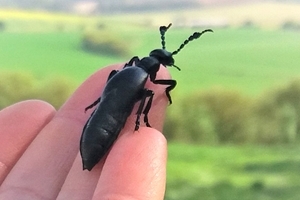Oil beetle
 Taking up the baton after ten years of Peter Thompson’s lively, enlightening and charming accounts of British wildlife is a tall order! If that isn’t enough to induce writer’s block, then ‘human’ was the previous Species of the Month – and I think we’d all agree that this subject was fittingly final, and awfully sobering.
Taking up the baton after ten years of Peter Thompson’s lively, enlightening and charming accounts of British wildlife is a tall order! If that isn’t enough to induce writer’s block, then ‘human’ was the previous Species of the Month – and I think we’d all agree that this subject was fittingly final, and awfully sobering.
However, I did let myself in for it, so here goes…
One of the things that makes Pete special is that he has an insatiable appetite for discovery and knowledge, and I have a fond memory of a time we jointly stumbled across a new species. In March 2017, we were having a sunny stroll on Pentridge Hill in Dorset – a lovely chalk downland Site of Special Scientific Interest with stunning panoramic views. It falls within the Farmer Cluster that I work with on Cranborne Chase, and it’s my favourite spot for a sandwich after hours of fieldwork!
As we walked along the patchy grass footpath on the spine of the hill, I spied something large, black and shiny busily digging in the path. It was a beetle – quite a bizarre-looking one! It was about an inch and a half long, and its body looked like an arrangement of ebony beads – large ones for its head, thorax and abdomen, and tiny strings for its legs and antennae. We remarked on its bluish-violet tint, and its sausage-like abdomen, which was bursting out of the wing cases on its back. What was this thing? We took lots of photos and watched it resume its digging before heading off again, dodging several more along the path home.
We later found out it was an oil beetle – a precious and declining group of five beetles that live in calcareous grasslands, dunes, heaths and woodlands. They are a member of the wider ‘blister beetle’ family, Meloidae. They are so called because they squirt irritating oily droplets from their joints when alarmed.
As I read about oil beetles, I found that they have an intriguing life cycle and I understood why our friend on Pentridge Hill was digging. She had recently emerged and mated, and her abdomen was swollen with eggs, for which she had to dig a nest. Oil beetles select bare, compacted earth – so footpaths are perfect.
Once the eggs hatch, the ant-sized larvae (called ‘triungulins’) shimmy up the nearest flower stem and lie in wait for a solitary bee to visit. Then they climb aboard, and the unsuspecting bee flies back to her nest with the hitchhiking parasites. Here the beetle larvae feast on the bee eggs, before pupating and emerging the following year as an adult to begin the cycle again. It’s fortunate that the female oil beetle lays up to a thousand eggs, because many hopeful larvae will jump on the wrong type of flower visitor! In fact, this strategy is made more difficult by the fact that each species of oil beetle is thought to prefer a different genus of solitary bee.
After close scrutiny of Pete’s photos we decided that ours was a black oil beetle (Meloe proscarabaeus), but there are also violet, rugged, short-necked and Mediterranean varieties. Three further species are thought to be extinct in the UK, but who knows? Like any rare species, they could be lurking somewhere no one has looked.
The reason for their decline is thought to be a combination of land-use change and declines in solitary bees. Restoring and protecting wildflower-rich habitats can help maintain these vital wild bee populations. In oil beetle hotspots, raising awareness is really important, as squishing one female on a footpath ends the chances of the thousand offspring she carries, and the odds are stacked against them even if they do hatch!
Keep an eye out for these impressive metallic ebony beetles when you’re on footpaths in warm, sunny flower-rich habitats in spring. If you pick one up, be gentle – otherwise you might get squirted with the oily irritant. In this case, it might be worth finding a lesser celandine flower as a peace offering – apparently oil beetles are quite partial to this spring snack!
Jess Brooks
Advisory

Get Peter Thompson's essential 26-page book, featuring beautiful photography and detailed profiles of Britain's wildlife, for just £1.99.
Find out more >